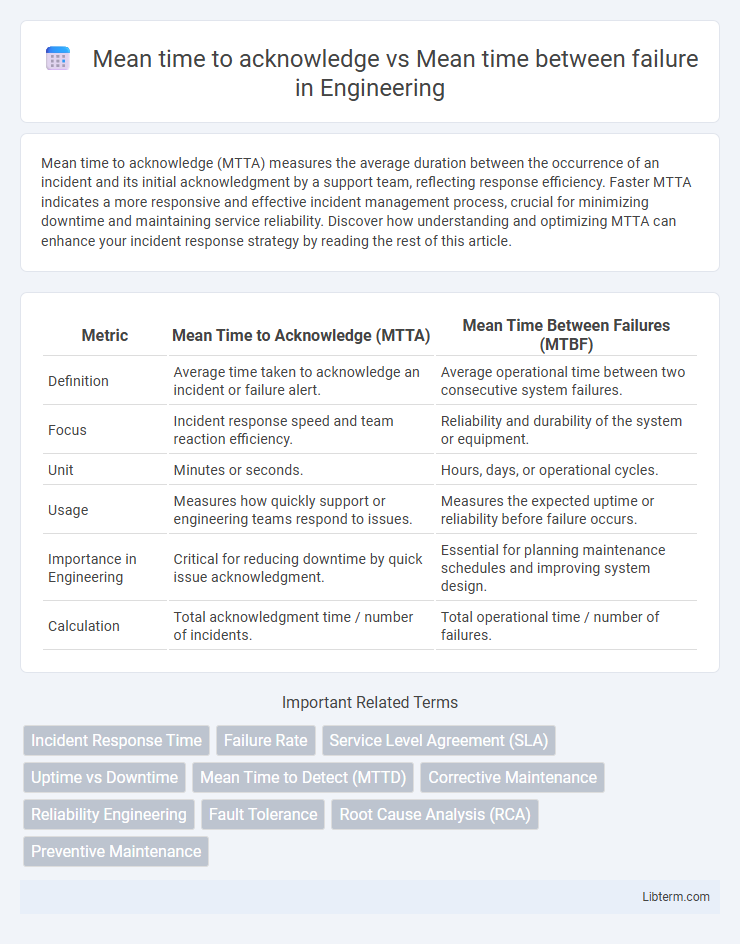Mean time to acknowledge (MTTA) measures the average duration between the occurrence of an incident and its initial acknowledgment by a support team, reflecting response efficiency. Faster MTTA indicates a more responsive and effective incident management process, crucial for minimizing downtime and maintaining service reliability. Discover how understanding and optimizing MTTA can enhance your incident response strategy by reading the rest of this article.
Table of Comparison
| Metric | Mean Time to Acknowledge (MTTA) | Mean Time Between Failures (MTBF) |
|---|---|---|
| Definition | Average time taken to acknowledge an incident or failure alert. | Average operational time between two consecutive system failures. |
| Focus | Incident response speed and team reaction efficiency. | Reliability and durability of the system or equipment. |
| Unit | Minutes or seconds. | Hours, days, or operational cycles. |
| Usage | Measures how quickly support or engineering teams respond to issues. | Measures the expected uptime or reliability before failure occurs. |
| Importance in Engineering | Critical for reducing downtime by quick issue acknowledgment. | Essential for planning maintenance schedules and improving system design. |
| Calculation | Total acknowledgment time / number of incidents. | Total operational time / number of failures. |
Introduction to MTTA and MTBF
Mean Time to Acknowledge (MTTA) measures the average time taken from the occurrence of an incident to its initial acknowledgment by the support or operations team, highlighting responsiveness in incident management. Mean Time Between Failures (MTBF) quantifies the average operational time between inherent system failures, reflecting the reliability and stability of equipment or software. Both MTTA and MTBF are critical metrics in IT service management and maintenance, where MTTA focuses on incident detection and response speed, while MTBF emphasizes overall system durability and maintenance intervals.
Defining Mean Time to Acknowledge (MTTA)
Mean Time to Acknowledge (MTTA) measures the average duration between the generation of an alert and the acknowledgment by response teams, reflecting incident detection efficiency. It differs from Mean Time Between Failure (MTBF), which quantifies the average operational time between inherent system failures, focusing on system reliability rather than response speed. MTTA is a key metric in IT incident management, vital for reducing downtime and improving service-level agreements (SLAs).
Understanding Mean Time Between Failure (MTBF)
Mean Time Between Failure (MTBF) quantifies the average operational time between system breakdowns, serving as a critical metric for assessing equipment reliability. Unlike Mean Time to Acknowledge (MTTA), which measures responsiveness to incidents, MTBF provides insight into the inherent durability and maintenance needs of hardware or software systems. Accurate MTBF analysis informs preventive maintenance strategies and reduces unexpected downtimes, enhancing overall system availability.
Key Differences Between MTTA and MTBF
Mean Time to Acknowledge (MTTA) measures the average time taken for a team to recognize and respond to an incident after it occurs, focusing on incident response speed. Mean Time Between Failure (MTBF) calculates the average operational time between system breakdowns, indicating overall system reliability and uptime. MTTA emphasizes response efficiency, while MTBF provides insight into system durability and maintenance needs.
Importance of MTTA in Incident Management
MTTA (Mean Time to Acknowledge) measures the average time taken for a team to recognize and respond to an incident, which directly impacts the efficiency of incident management and minimizes system downtime. MTBF (Mean Time Between Failure) tracks the average elapsed time between system failures, providing insights into overall system reliability but not response speed. Prioritizing MTTA improves operational resilience by reducing incident resolution delays, enhancing service availability, and supporting proactive incident handling strategies.
Role of MTBF in System Reliability
Mean Time Between Failure (MTBF) quantifies the average operational time between system breakdowns, serving as a critical parameter to evaluate system reliability and predict maintenance schedules. It directly impacts system availability by indicating the frequency of failures and informing design improvements to enhance durability. Unlike Mean Time to Acknowledge (MTTA), which measures response speed to incidents, MTBF provides a foundational metric for long-term reliability and system robustness planning.
Measuring and Calculating MTTA and MTBF
Mean Time to Acknowledge (MTTA) measures the average time taken for a system or support team to respond to an incident after it is detected, calculated by dividing the total time taken to acknowledge all incidents by the number of incidents. Mean Time Between Failures (MTBF) quantifies the average operational time between inherent failures in a system, determined by dividing the total operational uptime by the number of failures within a specified period. Accurate measurement of MTTA involves tracking incident detection to first response time, while MTBF requires detailed failure logs and uptime data to reflect system reliability.
Impact of MTTA and MTBF on Business Operations
Mean Time to Acknowledge (MTTA) directly influences incident response efficiency, minimizing system downtime and enhancing customer satisfaction by enabling quicker detection and resolution of issues. Mean Time Between Failure (MTBF) measures system reliability, with higher MTBF values indicating fewer breakdowns, reducing maintenance costs and operational disruptions. Optimizing MTTA and MTBF improves overall business continuity, boosts productivity, and supports stronger service level agreements (SLAs).
Strategies to Improve MTTA and MTBF
Improving Mean Time to Acknowledge (MTTA) involves implementing real-time monitoring systems and automated alerting to ensure rapid detection and response to incidents. Enhancing Mean Time Between Failure (MTBF) requires proactive maintenance strategies such as predictive analytics, comprehensive equipment inspections, and component quality improvements to reduce the frequency of failures. Integrating these approaches optimizes operational reliability and minimizes downtime in critical systems.
Conclusion: Choosing the Right Metric for Your Needs
Mean Time to Acknowledge (MTTA) emphasizes the speed of response to incidents, making it essential for organizations prioritizing rapid detection and initial reaction in IT operations. Mean Time Between Failure (MTBF) measures system reliability by calculating average operational time between failures, suited for maintenance planning and long-term system improvement. Selecting between MTTA and MTBF depends on operational goals: prioritize MTTA for incident management efficiency and MTBF for durability and preventive maintenance strategies.
Mean time to acknowledge Infographic

 libterm.com
libterm.com